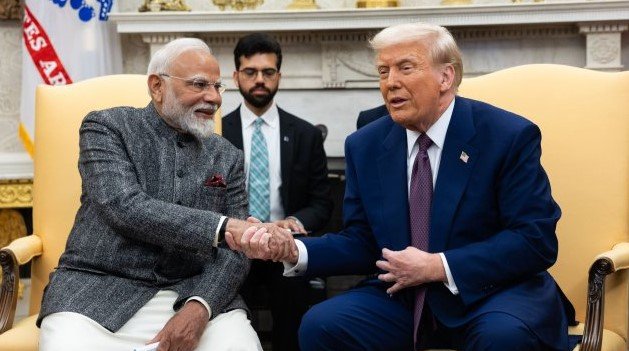As the clock ticks toward an August 1 deadline, India is scrambling to close a trade deal with the United States that could determine the country’s economic trajectory for years. With U.S. President Donald Trump publicly touting a near-final agreement, Indian negotiators are pushing hard behind closed doors for tariff concessions even more favorable than those granted to Indonesia — a bold bid that underscores New Delhi’s urgency, confidence, and geopolitical tightrope walk.
Sources in the Indian government say that Prime Minister Narendra Modi’s administration is unwilling to settle for a carbon copy of Jakarta’s agreement. Trump announced on Tuesday that Indonesian imports to the U.S. would face a 19% tariff, reduced from a previously threatened 32%. American exports, meanwhile, would enjoy zero-duty access into Indonesia. India is aiming for something sharper — a rate lower than 19% on Indian goods entering the U.S., along with reciprocal privileges for American products.
Political Theater, Real Stakes
Publicly, both sides are speaking optimistically. Trump told reporters this week the India deal was “very close,” echoing a similar tone he used when confirming the Indonesia tariff revision. “It’ll be along the same line,” he said, hinting that Washington expects comparable concessions from New Delhi. “We’re going to have access into India.”
But Indian officials insist that a “copy-paste” deal won’t fly. “India’s trade volume with the U.S. is larger than Indonesia’s and far more diversified,” said one senior Indian trade official, speaking on condition of anonymity. “We deserve and expect better terms.”
For the Modi government, agreeing to Trump’s terms without extracting symbolic wins would be politically costly — especially with a major round of state elections due this winter.

Race Against the August Clock
Trump has imposed a strict August 1 deadline for all countries seeking to avoid the full brunt of his unilateral tariff regime. For India, the stakes are particularly high. Not only is the U.S. India’s largest export market, but several key sectors — from pharmaceuticals to textiles — would be disproportionately hit by tariffs above 15%.
Officials involved in the talks say the current sticking points include:
-
The base tariff level on Indian engineering goods, currently proposed at 18.5%
-
A 10-year moratorium period India wants on any tariff hikes
-
U.S. demands for deeper agricultural market access, especially for soy and almonds
-
Disagreements over digital service taxes India currently imposes
India, for its part, is reportedly offering deeper tariff reductions on U.S. aircraft parts and willing to grant longer patent protection for American pharmaceutical companies — both longtime U.S. demands. But it is resisting changes to data localization rules and its sovereign taxation authority.
Jakarta Deal Sets a Benchmark
Indonesia’s agreement has become the benchmark — and also the floor — for India’s negotiation. Trump had initially threatened a 32% tariff on Indonesian imports, but under pressure from U.S. agri-exporters and the State Department, that was reduced to 19%. In exchange, Jakarta agreed to eliminate tariffs on over 80 categories of U.S. goods, including pork, corn syrup, and defense equipment.
Indian negotiators fear that accepting identical terms would appear like strategic timidity — or worse, a missed opportunity. “We are not Vietnam, and we are not Indonesia,” said a second Indian official close to the talks. “The scale, the market, and the political calculus are all different.”
Modi’s Quiet Diplomacy
Unlike previous trade flare-ups between the two nations — particularly under Trump’s first term when India was removed from the GSP (Generalized System of Preferences) — this round of talks has been unusually discreet.
Modi, who has cultivated a close personal rapport with Trump over the years, is said to be relying on direct backchannel communication. The Indian prime minister’s office has reportedly reached out to senior members of Trump’s campaign staff as well as Republican lawmakers to build broader political goodwill in Washington, especially amid the U.S. election season.
Still, the Indian business lobby is anxious. “We’re already under pricing pressure in textiles and chemicals,” said Arvind Mangal, a Mumbai-based exporter. “A 20% U.S. tariff would kill margins completely.”
One Shot at Leverage
India’s strategy, analysts say, is about timing. With Trump preparing for his convention speech later this month and looking to notch tangible wins for his “America First” platform, New Delhi sees an opportunity.
“India has leverage right now because Trump wants to wrap up deals before the election spotlight intensifies,” said Akhil Bery, a trade expert at Asia Group Advisors. “If India plays it well, it can lock in a friendlier deal that outpaces Vietnam and Indonesia.”
So far, Vietnam has agreed to a 20% tariff ceiling in its deal with the U.S., without reciprocal zero-duty access for American exports. That makes India’s case even more compelling — both for economic and political reasons.
Tariff Terms Sought by U.S. from Asian Trade Partners (as of July 2025)
| Country | Proposed U.S. Tariff | Reciprocal Access for U.S. Goods | Deal Status |
|---|---|---|---|
| Indonesia | 19% | Yes (Zero-duty access) | Finalized July 15 |
| Vietnam | 20% | No | Draft terms agreed |
| India | Under negotiation | Conditional on tariff parity | Deadline: Aug 1 |
What Comes Next?
With just two weeks left, negotiators are preparing for a final sprint. A high-level Indian delegation is expected to fly to Washington next week for in-person talks, even as Trump weighs unveiling the agreement — or its collapse — during his Republican National Convention speech on July 29.
“The mood is optimistic, but nobody’s popping champagne yet,” said a third official. “This is still Trump. Everything is final — until it’s not.”
